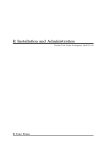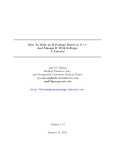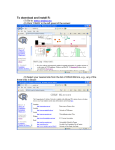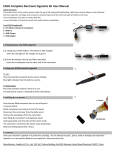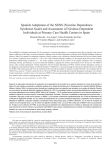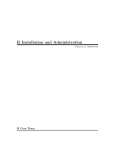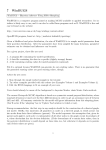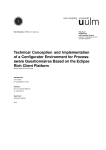Download iRepro package - installation and usage guidelines
Transcript
iRepro package - installation and usage guidelines
In this document we describe how to install the R package iRepro (files iRepro 1.0.tar.gz and iRepro 1.0.zip).
If you are able to install the package, but the package does not load, the issues should be resolved by updating to
the latest version of R (or at least to R version 3.0.0 or higher). Any updates to the package will be posted to the
R online package repository, http://cran.r-project.org/.
1
1.1
Installing the iRepro package on Windows
Installation from iRepro 1.0.tar.gz file
To install the package from iRepro 1.0.tar.gz file, you will need the Rtools (available from http://cran.
r-project.org/bin/windows/Rtools/).
Download the file iRepro 1.0.tar.gz. In R, change working directory to the directory where iRepro 1.0.tar.gz
is saved (by using command setwd in R Console or by clicking File → Change dir ). To install the package, type
install.packages("iRepro 1.0.tar.gz", repos=NULL, type="source")
in R console.
Note: If installation did not complete correctly, the issues should be resolved by updating to the latest version
of R. Otherwise, installation from iRepro 1.0.zip file should work correctly.
1.2
Installation from iRepro 1.0.zip file
Download the file iRepro 1.0.zip. In R, click Packages → Install package(s) from local zip files and select the
downloaded file.
2
Installing the iRepro package on OS X
The procedure is the same as in 1.1 (except that the Rtools is not needed).
3
Using the iRepro package to estimate ICC from grouped data
The iRepro package calculates ICC from any kind of interval-censored data, not necessarily grouped. In this
section we work through one example of grouped data.
For each predefined category in questionnaire, we first need to specify category label and cut-off points, e.g.,
for the question “How many cigarettes/day do you smoke” (from the Fagerström Test for Nicotine Dependence1 ):
Category
10 or less
11 - 20
21 - 30
31 and more
Label
0
1
2
3
Lower cut-off point
0
10.5
20.5
30.5
Upper cut-off point
10.5
20.5
30.5
40
In iRepro’s main function intervalICC, category labels correspond to the argument classes, while cut-off
points correspond to c.limits. In R, we would type:
1
classes <- 0:3
c.limits <- matrix(c(0,10.5,10.5,20.5,20.5,30.5,30.5,40), byrow=TRUE, nrow=4)
Now we specify questionnaire data. If we have N = 10 respondents, we need to specify two vectors of length N
consisting of category labels, e.g.,
q1 <- c(0,0,3,2,1,0,1,2,1,0)
q2 <- c(0,1,2,3,1,0,0,2,1,0)
In our example, this would mean that the first respondent answered that he smoked 10 or less cigarettes in
both questionnaires. The second respondent selected the category “10 or less” in the first questionnaire and the
category “11-20” in the second one, and so on. Finally, calling
intervalICC(r1=q1, r2=q2, predefined.classes=TRUE, classes=classes, c.limits=c.limits)
gives us ICC of 0.87. In the case that the data require transforming (such as adding a constant and applying
natural logarithm, which would be appropriate in this example), the transformation needs to be applied only to
c.limits.
For more information on the package or its functions, please consult the iRepro user manual.
References
1.
Heatherton TF, Kozlowski LT, Frecker RC, Fagerström KO. The Fagerström test for nicotine dependence: a
revision of the Fagerström Tolerance Questionnaire. Br J Addict. 1991;86:111927.
2


